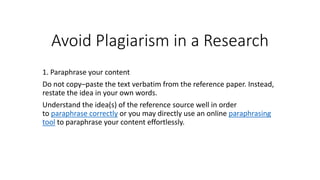plagarism tips.pptx
- 1. Avoid Plagiarism in a Research 1. Paraphrase your content Do not copyĻCpaste the text verbatim from the reference paper. Instead, restate the idea in your own words. Understand the idea(s) of the reference source well in order to paraphrase correctly or you may directly use an online paraphrasing tool to paraphrase your content effortlessly.
- 2. 2. Use Quotations Use quotes to indicate that the text has been taken from another paper. The quotes should be exactly the way they appear in the paper you take them from.
- 3. 3. Cite your Sources Identify what does and does not need to be cited The best way to avoid the misconduct of plagiarism is by self-checking your documents using plagiarism checker tools. Any words or ideas that are not your own but taken from another paper need to be cited. Cite Your Own MaterialĄŠIf you are using content from your previous paper, you must cite yourself. Using material you have published before without citation is called self-plagiarism. The scientific evidence you gathered after performing your tests should not be cited.
- 4. 4. Maintain records of the sources you refer to Maintain records of the sources you refer to. Use citation software like EndNote or Reference Manager to manage the citations used for the paper. Use multiple references for the background information/literature survey. For example, rather than referencing a review, the individual papers should be referred to and cited.
- 5. 5)Use plagiarism checkers You can use various plagiarism detection tools such as iThenticate or HelioBLAST (formerly eTBLAST) to see how much of your paper is plagiarised. Tip:While it is perfectly fine to survey previously published work, it is not alright to paraphrase the same with extensive similarity. Most of the plagiarism occurs in the literature review section of any document (manuscript, thesis, etc.). Therefore, if you read the original work carefully, try to understand the context, take good notes, and then express it to your target audience in your own language (without forgetting to cite the original source), then you will never be accused with plagiarism (at least for the literature review section).





